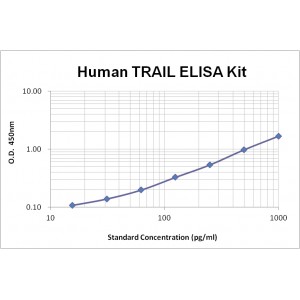More info
Assay Range | 15.6-1,000 pg/mL |
Sensitivity | 1.0 pg/mL |
Size | 96T |
Storage | Store at 2 - 8ºC. Keep reconstituted standard and detection Ab at -20 ºC |
Assay Principle | Sandwich ELISA |
Sample Volume | 100 µL final volume, dilution factor varies on samples |
Detection Method | Chromogenic |
Kit Components
1. Recombinant Human TRAIL standard: 2 vials
2. One 96-well plate coated with Human TRAIL Ab
3. Sample diluent buffer: 12 mL - 1
4. Detection antibody: 130 µL, dilution 1:100
5. Streptavidin-HRP: 130 µL, dilution 1:100
6. Antibody diluent buffer: 12 mL x1
7. Streptavidin-HRP diluent buffer: 12 mL x1
8. TMB developing agent: 10 mL x1
9. Stop solution: 10 mL x1
10. Washing solution (20x): 25 mL x1
Background
TNF-Related Apoptosis-Inducing Ligand (TRAIL), also called Apoptosis 2 Ligand (Apo2L), tumor necrosis factor ligand superfamily member 10, or CD253, is a member of tumor necrosis factor superfamily (TNFSF). TRAIL is a 281 amino acid (aa), type II transmembrane protein expressed on the cell surface with a highly conserved and singly glycosylated C-terminal extracellular domain, a transmembrane domain, and a short N-terminal cytoplasmic domain. Like other members of the TNFSF, TRAIL also exists in a soluble form. In the tumor necrosis factor superfamily, TRAIL is most closely related to Fas Ligand in sequence, structure and function. Human TRAIL is 65% aa sequence identical to its mouse counterpart.
TRAIL is widely expressed in various tissues including fetal kidney, liver, and lung, as well as adult colon, heart, kidney, lung, ovary, peripheral blood lymphocytes, placenta, prostate, skeletal muscle, small intestine, spleen, and thymus. Both membrane-bound and soluble TRAIL induce apoptosis through binding TRAIL receptors 1 (TRAIL R1/DR4) and 2 (TRAIL R2/ DR5). TRAIL also binds TRAIL R3 (DcR1),TRAIL R4 (DcR2), and osteoprotegrin (OPG), which act as decoy receptors and are critical to the regulation of TRAIL signaling by competing for TRAIL binding.


